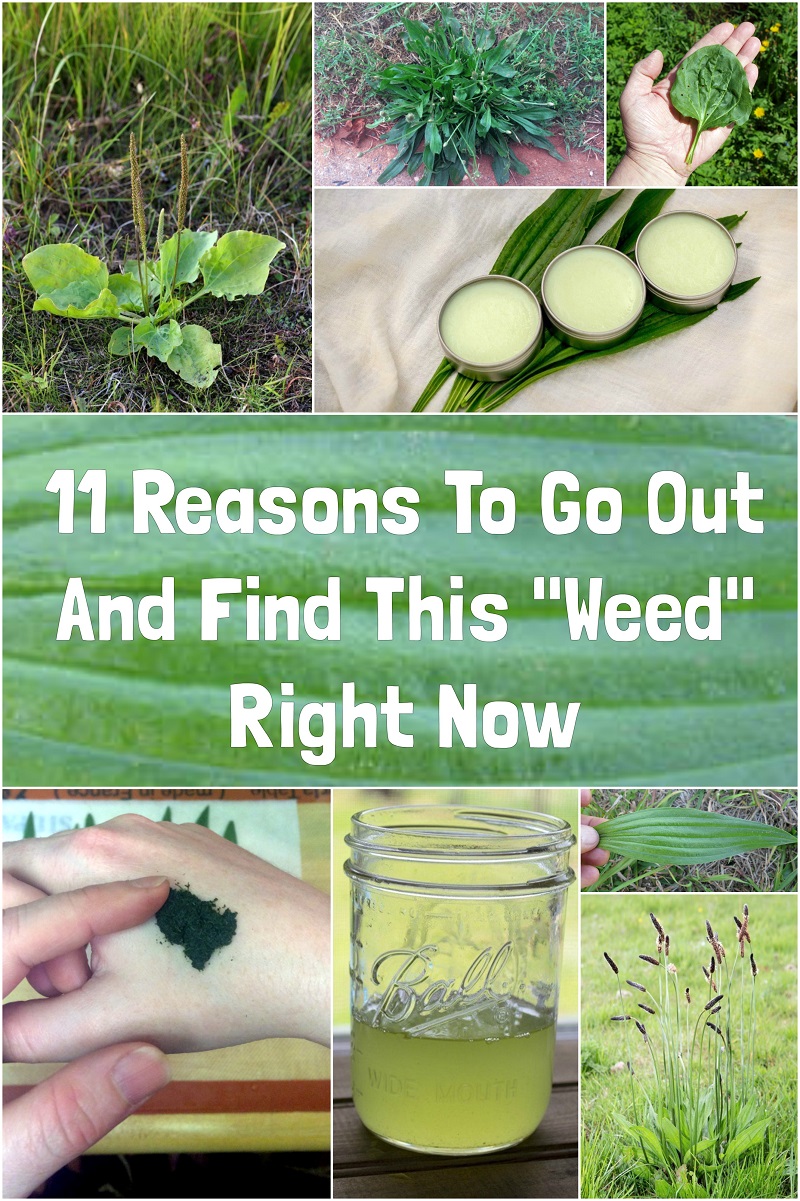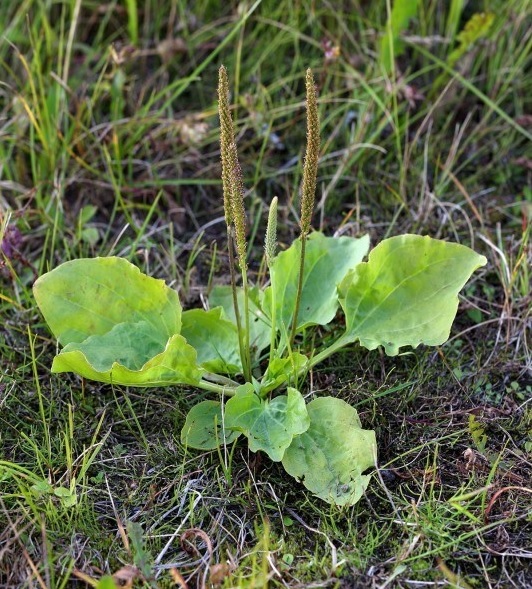
The plantains used as medicinal herbs are low-growing plants that you can find growing almost anywhere.
In some circles plantain is regarded as a weed, but it’s actually one of the best healing herbs on the planet.
Plantains have a long history of being used as food plants and healing herbs in many diverse cultures around the world. The Native Americans used it to heal wounds, cure fever, and to draw out toxins from stings and bites, including snakebites.
You might have come across mainly two types of plantains; the ones with broad leaves called Plantago major and the narrow-leaved type P. lanceolata.
You can use either one for healing purposes, depending on the availability in your locality, but most herbalists seem to prefer the broadleaf plantain with larger, but softer, edible leaves.
Health Benefits Of Plantain
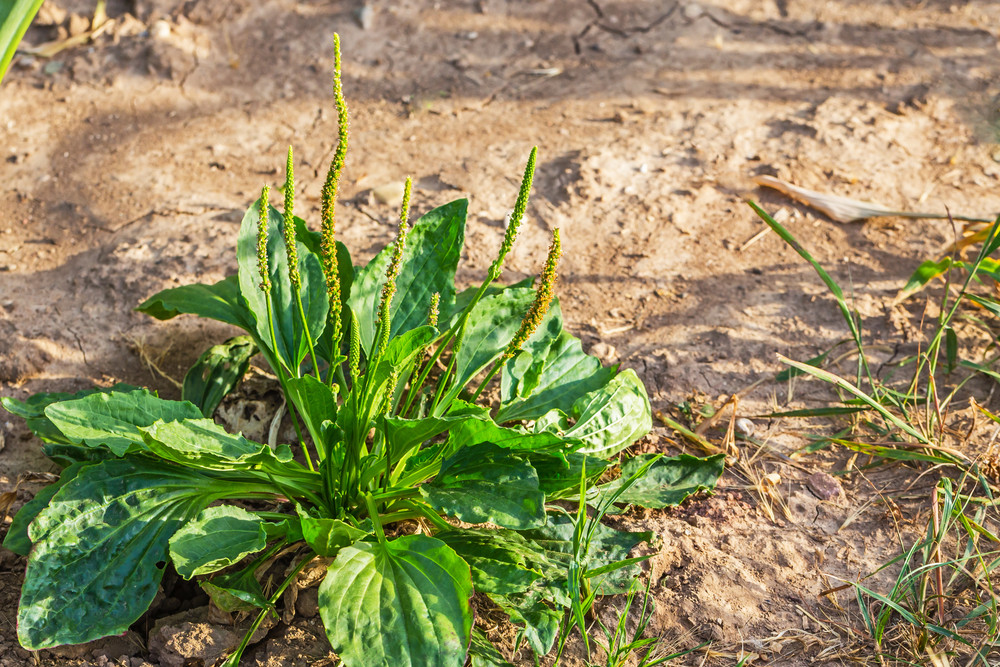
Plantains have wide-ranging antimicrobial properties besides being anti-inflammatory and analgesic. It can not only soothe insect bites and superficial wounds but prevent infections and accelerate healing.
An active biochemical aucubin is mainly responsible for the antimicrobial action of the herb. Another substance allantoin in the herb helps with skin tissue regeneration.
Plantains also have an astringent property that has a cleansing effect on the body. It helps dry up excess secretions in the respiratory tract and the digestive system, thus being useful in treating colds and diarrhea.
The astringency is moderated by the demulcent effect of the mucilage in the herb, so this herbal remedy is much gentler than other commonly used astringents.
The edible leaves of broadleaf plantain are rich in calcium and other minerals and vitamins, including Vitamin K. This vitamin helps stem bleeding from cuts and wounds. Tender leaves can be eaten fresh in salads, but older leaves have to be cooked.
How To Collect Plantain Herb
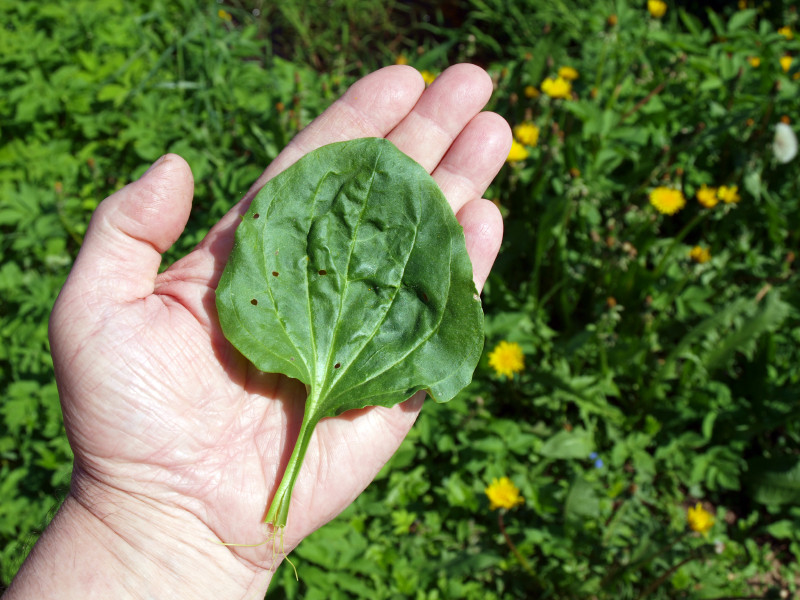
Despite their medicinal and nutritional value, plantains have a weed status, and are, in fact, invasive in many areas.
If you find them growing in abundance in wastelands in your area, it’s better to gather them from there, rather than introduce them into your garden. But make sure that the area is clean, and not chemically treated.
Most importantly, you should be able to positively identify the correct plant. The plants don’t have any stems above the ground. All you see is a tuft of leaves coming from a point.
The characteristic flower stalks help identify plantain among other rosette-forming plants, but they may not be present all the time. If you are in doubt, get the help of a knowledgeable person.
Plantain leaves are mainly used for herbal preparations, so it is best to pick just the leaves, rather than dig out the entire plant.
Pinch off unblemished leaves, selecting slightly mature ones over the very tender leaves, unless you’re planning to use them in salads. Mature leaves have a higher concentration of potent phytochemicals.
11 Ways To Use Plantain For Healing
Plantain is used to treat a variety of everyday problems, from mosquito bites and skin rashes to kidney problems and gastrointestinal inflammatory diseases. Let’s see how you can use this herb for healing.
Burns – Apply a poultice immediately and apply a bandage with leaves. Follow it up with a plantain salve.
Cuts and open sores – Stop bleeding from fresh cuts by applying crushed plantain leaves. Wash with plantain tea or diluted tincture (1 tbsp to a glass of water) to prevent infections and promote healing.
Boils and acne – Touch with a drop of tincture or apply salve.
For mouth ulcers – Swish 2-3 Tbsp plantain tea in the mouth 3-4 times a day. You can use 1 tbsp of tincture diluted with a cup of water too.
For throat pain/infection – Gargle with plantain tea or diluted tincture. Take 5-10 drops of tincture under the tongue and ingest it slowly.
Dandruff and other scalp problems – Apply plantain tea or oil infusion to the scalp and wash off after an hour.
For poison ivy/sumac/oak – Apply a poultice immediately, and then wash the area with plantain tea. Apply plantain sludge (more details at the end of this article) until the stinging pain is gone.
For sunburn – Apply fresh poultice or plantain sludge liberally. Wash the area with the tea and then apply the salve.
To improve liver and kidney function – Drink 1-2 glasses of plantain tea every day.
For relief from gastrointestinal inflammation – Take the tincture under the tongue or drink plantain tea.
For cold, flu, and respiratory infections – Take the tincture under the tongue or drink freshly brewed warm tea with honey.
How To Make Plantain Poultice
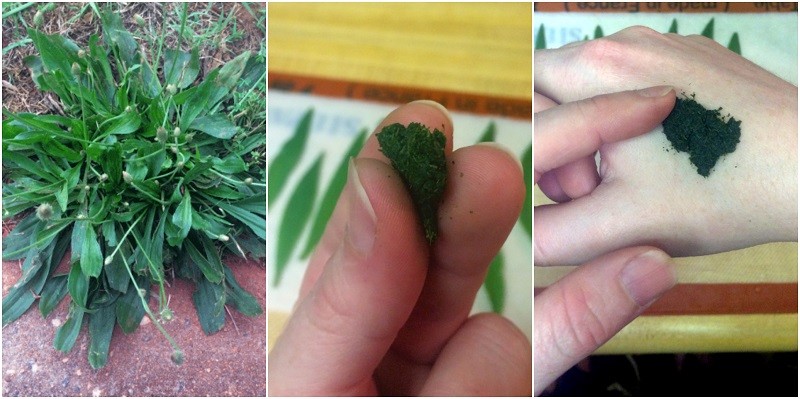
This is the quickest, and reportedly the most effective, way to use this healing herb. Keep a mental note of where you can find it in the garden or yard in an emergency.
In case of an insect bite, bee sting, or poison ivy exposure, grab a few leaves, crush them between the palms, or pound them with a stone, and apply directly on the skin. If you are using it on yourself, just chew the leaves and use it as a poultice.
The mucilage from the bruised leaves will immediately soothe the pain while the anti-inflammatory effect of the herb reduces swelling and redness. The poultice will also draw the toxins from the sting, so it works best when applied immediately.
Read More: How To Make A Plantain Poultice
How To Make Plantain Tea
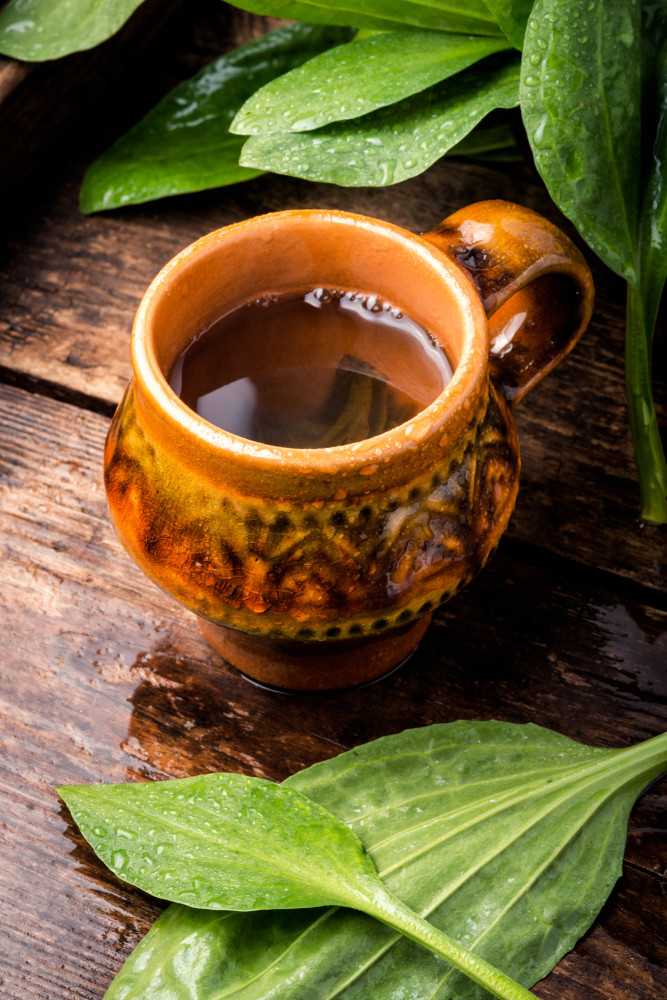
You will need:
- Fresh plantain leaves – 1 cup
- Water – 2 cups
- Heat-proof bowl with fitting lid
- Wash the plantain leaves thoroughly and keep it in a bowl with lid.
- Boil the water and pour over the leaves in the bowl, cover with the lid and let them steep until the bowl is cold to touch.
- Strain out the tea and store in the refrigerator for up to two weeks.
Drink 1-2 cups of this plantain tea a day to control diarrhea or to get relief from the symptoms of cold and fever. You can drink it plain or add honey for taste.
It can bring relief to people who have stomach ulcers, IBS or other inflammatory diseases of the gastrointestinal tract. Plantain tea can be used as a general tonic too.
Use plantain tea topically to wash wounds, boils, and skin damaged by sunburn, rashes, eczema etc.
How To Make Plantain Salve
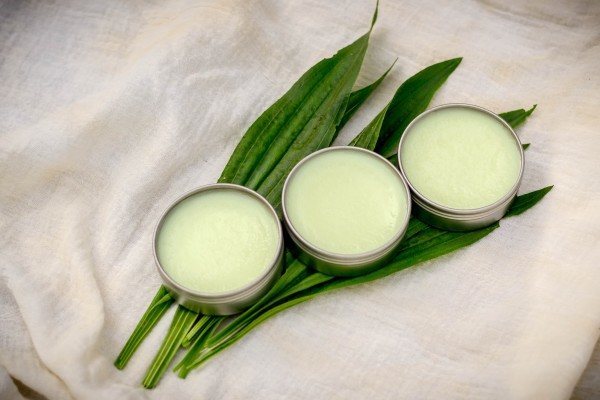
Keeping a tub of plantain salve handy can be so useful in situations when you cannot run out to get the herb.
It is an excellent first aid for cuts and bruises, insect bites, poison ivy attacks, and skin rashes and eruptions that suddenly appear for no apparent reason. You can even use it in small amounts as a diaper cream for babies.
To find out how to make a plantain salve, visit our full step-by-step tutorial here.
Tips:
Use this healing salve on skin rashes, chapped skin, insect, and spider bites. It is excellent for regular use on eczema and psoriasis-affected skin.
To make sure that the salve lasts for some time without any preservatives, gather the leaves on a dry day, and dry them thoroughly after washing.
Since coconut oil naturally solidifies at room temperature (below 75F), you can make this preparation without beeswax, but the salve will have a creamy consistency. You can make the oil infusion with olive oil or castor oil for use on the scalp.
How To Make Plantain Tincture
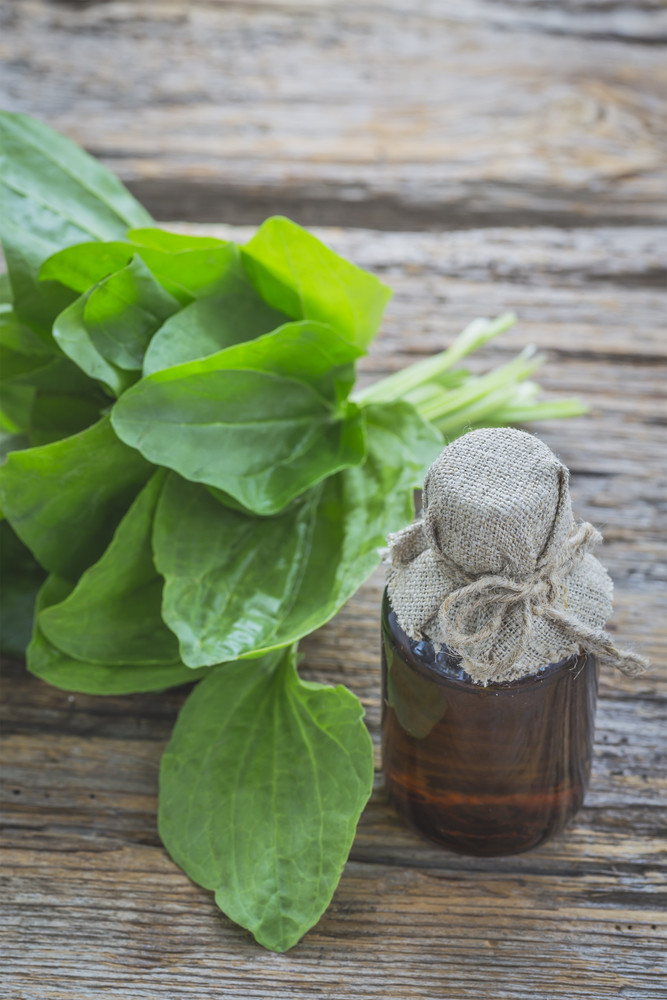
You will need:
- Plantain leaves washed and dried of excess moisture – 1 cup
- 100 proof vodka or brandy – 1 pint
- Glass jar with tight-fitting lid
Method:
- Put the leaves into a jar and pour the alcohol over it so that it completely covers the leaves and fills the jar. Use a glass rod to stir the mixture well.
- Put the lid on and place the jar in a dark place, giving it a good shake every few days.
- After 6-8 weeks, decant into clean bottles and store in a dark place.
Tips:
The tincture made with plantain leaves and 100% alcohol can last for two to three years without losing its potency.
It is a very potent remedy for cold, respiratory infections and ailments of the stomach. Use 10 drops under the tongue and hold for 30 seconds before swallowing. You can add 10 drops of the tincture into a glass of water and drink slowly. For external use, put a drop on boils and sores.
Plantain Leaf Sludge
The sludge obtained from draining the tea can be applied as a cooling and healing poultice on your face, shoulders and back red and raw from sunburn.
Similarly, the residue left over from the oil infusion can be used to ease burns, eczema, and psoriasis. Grind it to get a more uniform paste.
